As an agency, marketing is absolutely pivotal to your chances of growth and success. If you’re unable to identify, reach, and grab the attention of your potential clients, then the consequences are simple — your business won’t survive.
However, that doesn’t mean that you should simply throw some money at a Google Ads campaign, or start posting on social media for the sake of it. For your marketing to be effective, it needs to be thought-out, structured, and efficient, which means creating a marketing plan.
In this article, we’ll explain how you can do this, as well as provide you with a free marketing plan template to get you started.
What Is a Marketing Plan?
A marketing plan is essentially an outline of your marketing strategy for a defined period of time, such as a quarter or a year (depending on your agency’s preference).
Usually structured as a report, it defines the overall marketing goals for that period and provides a detailed timeline of how those goals are going to be met. This is important, as these “milestones” represent an actionable, practical roadmap of how your goals are going to be achieved.
The report should also specify the key performance indicators (KPIs) that you are going to use to track and measure the progress and eventual success of these goals.
Marketing Plan vs Marketing Strategy
At this point, it’s important to clarify the difference between a marketing plan and a marketing strategy.
Your marketing strategy (which will itself be shaped by your business strategy) is the purpose of your marketing efforts; the end goal that you want to achieve. Your marketing plan represents the actual execution of these efforts, and is a detailed blueprint of how you are going to reach that end goal.
These two concepts should not be confused, and one shouldn’t be used to replace the other, either. Remember: a marketing plan cannot exist without a marketing strategy, and you can’t execute your strategy without having a marketing plan.
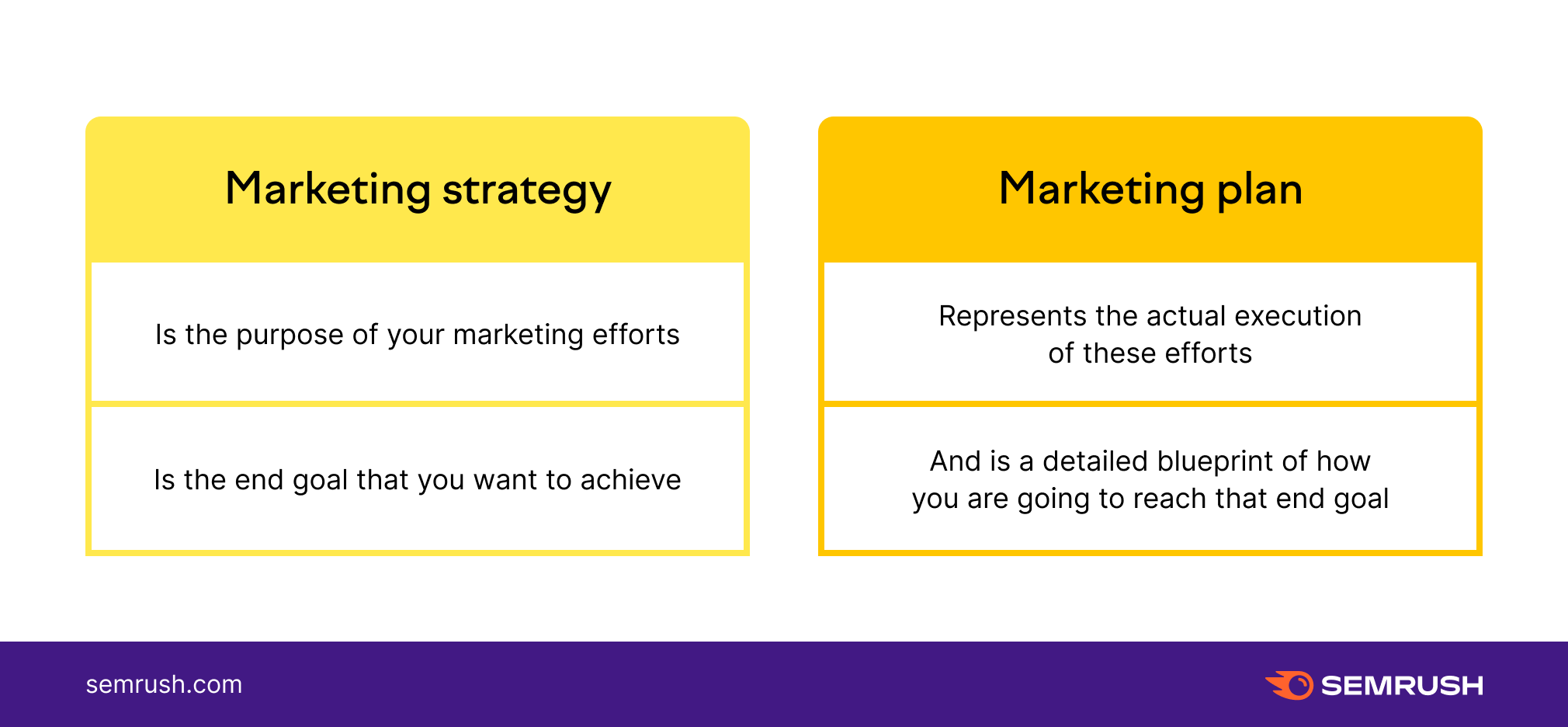
Why Do You Need a Marketing Plan?
The most obvious argument for implementing a marketing plan is that, without one, there is no structure or organization for what needs to be done. Every agency wants to grow, of course, but without a detailed framework that breaks down each step into a series of actionable tasks, you’re essentially playing a game of hit and hope.
A marketing plan also helps you to build up your online presence from day one, measure progress more effectively, and understand the different factors that may be having an impact on your success. This, in turn, can allow you to hone your brand messaging, and define your marketing tactics and techniques for selling, creating a cycle of success.
Consider, too, that your marketing budget is likely to be one of your agency’s highest costs. Therefore, you want to ensure that every cent is generating value. It’s far more economical if you take the time to research and structure which channels, audiences, and platforms you are going to target (as well as what resources you are going to need), as opposed to adopting an ad-hoc approach.
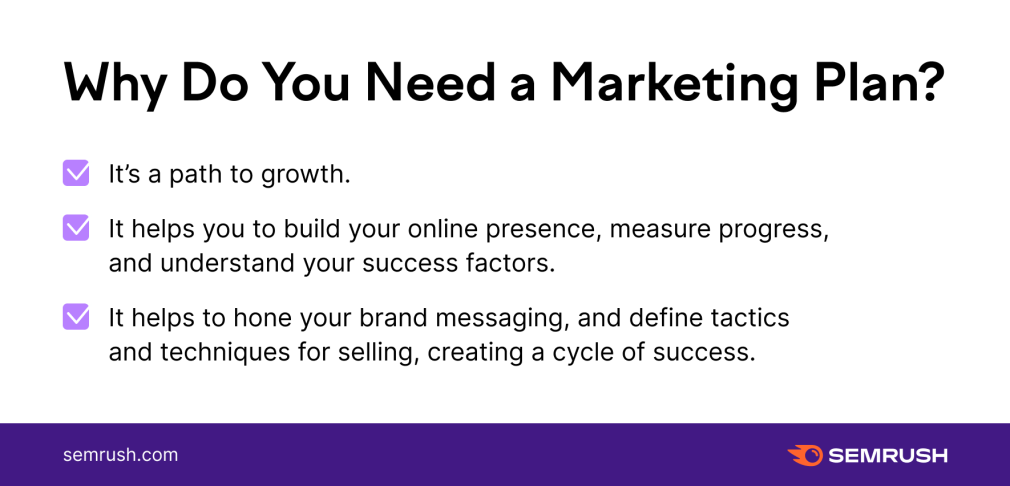
Types of Marketing Plans
Marketing plans are meant to be flexible. That means that they don’t just have to be high-level; they can be broken down by channel, type, or even individual goal.
For example, you may have a high-level strategic marketing plan that specifies your agency’s broader marketing goals for the next three months, while also having tailored, more detailed plans for your social media and email channels. At the same time, you may have a new feature, product, or service coming out that you want to dedicate a specific marketing plan to.
Here are some of the different kinds of marketing plans that could be relevant for your agency.
Quarterly or Annual Marketing Plan
As mentioned, the most popular type of plan is by quarter or year (or even six-monthly), as these time frames allow you to utilize existing data trends and set more realistic goals. For instance, you may have noticed in Organic Research that your organic traffic has doubled year-on-year for the last two years, so it’s a reasonable goal to try and continue (or exceed) that trend for the coming year.
Depending on the size of your agency, the channels you’re using, and the breadth of your goals, you may only need to create one plan. If your marketing mix is a little more complex, though, it can serve as more of a high-level overview.
Digital Marketing Plan
If you run both online and offline campaigns, then this plan allows you to focus solely on your digital efforts. While not as high-level as an annual/quarterly plan, it is still more of an overview of your concurrent digital activities and is perfect for when you are combining the use of multiple online channels to achieve your goal.
For instance, you might outline how you are going to implement a paid ads campaign alongside a targeted email marketing campaign to achieve a certain goal, while also outlining how your social media posts and organic content are going to support that.
Content Marketing Plan
This is where we start to break things down at a granular level. Content marketing is a more narrow scope of focus, so here you would look to outline — in detail — how you are going to leverage your content strategy to achieve your goal.
For example, your goal might be to start ranking in the top 10 search results for a particular keyword by the end of the quarter. Your plan might outline the proposed creation and publication of a content hub (including topics, posting schedules, and promotional channels) to help you make that goal a reality.
Social Media Marketing Plan
The same concept applies to social media, where you can illustrate the channels you are looking to target, and the content you are going to post.
It’s important here to actually have a strategy for your social media. If your plan simply says “post 5 times a week on Instagram between 9 am and 11 am” then that’s great, but how does that help you meet your goal of, say, growing your followers by 15% by the end of the quarter?
You don’t have to give a blow-by-blow breakdown of every single post, but you should specify what the purpose of your content is and how it will help you to meet your targets.
Event Marketing Plan
Given the current global situation, this type of plan may not be your priority any time soon. But in more “normal” circumstances, event marketing is likely a crucial element of your B2B marketing efforts.
This is why you should plan out your event marketing activities. Specify which events you think could be the most beneficial for your agency (and why), and outline what you hope to achieve at each event.
Maybe you have a certain number of leads you want to generate, or you have a select list of carefully researched and targeted industry clients whose business you want to secure by the end of the quarter. An event marketing plan allows you to stay on track, avoid distractions, and focus on how exactly you’re going to make these things happen.
Email Marketing Plan
Email is a hugely popular and effective way to support or drive any marketing campaign, and so your activities need to be planned out very carefully. Luckily, there is a wealth of data available with which to analyze email campaigns, so you can be pretty specific.
It’s important to specify what the goals of your campaigns are, how you are segmenting them, and how this is likely to help you achieve your goal. You can lean on data you have obtained from previous campaigns to help with this, and to ensure that your campaigns are clearly laid out and have the best chance of success.
Integrated Marketing Plan
If you are integrating multiple channels to achieve your marketing objectives, then it’s a good idea to draw up an integrated marketing plan (as opposed to creating several separate plans). This ensures that all your activities are aligned and coordinated, and that there is a consistent focus among them.
New Product Launch Marketing Plan
Depending on your chosen marketing channels, this plan is similar to an integrated marketing plan. However, the difference is that your goals are not measured over a set period of time, such as a quarter, but for a particular event — in this case, a product launch.
The principle remains the same in that you will still have predefined goals that you want to achieve, but you also have to take into account how your marketing activities align with the product team’s activities. As a result, you will need to be more flexible when creating your plan, and anticipate that certain activities and goals may change or be affected by things beyond your control.
Small Business Marketing Plan
As a small business, your marketing goals are likely to be decidedly different and less complex than multinational behemoths with presences in multiple locations. Therefore, it makes no sense to try and structure your marketing plan in a similar way.
You’re also (although not always) likely to be more restricted in terms of your budget, so the purpose of this plan is to focus on the key channels and activities that will allow you to grow and generate targeted leads.
Your goals here should be realistic and take into account the resources you have available; for example, if you want to generate an organic traffic presence, then that’s great. But as a small enterprise, do you have a content writer available to write that content? Do you have the budget to outsource it? Always ensure that you outline how exactly you’re going to achieve your objectives.
B2B Marketing Plan
As an agency, this kind of plan is likely to be suitable by itself, but if you also happen to target B2C audiences, it’s good to differentiate.
As the name suggests, this plan should focus solely on your B2B marketing activities and how they are all going to align with one another. To judge the success of your plan more effectively, you will probably want to go off the number of qualified leads you generate as opposed to actual paying clients, as the responsibility for converting those leads will likely lie with your sales team.
Marketing Plan Examples
So, what do marketing plans actually look like in practice? To give you an idea, here are two examples: an executive summary marketing plan, and a one-page marketing plan.
Executive Summary Marketing Plan
Within your marketing plan, you are likely going to be covering a lot of detail, especially if you are running multiple campaigns across different channels and platforms. As a result, it’s a good idea to create an executive summary that succinctly condenses all these key goals and activities into a couple of pages at the start of your document.
Take the below example, which is from a marketing plan for the sports clothing company Vans. This particular plan is targeted at their New Zealand market:
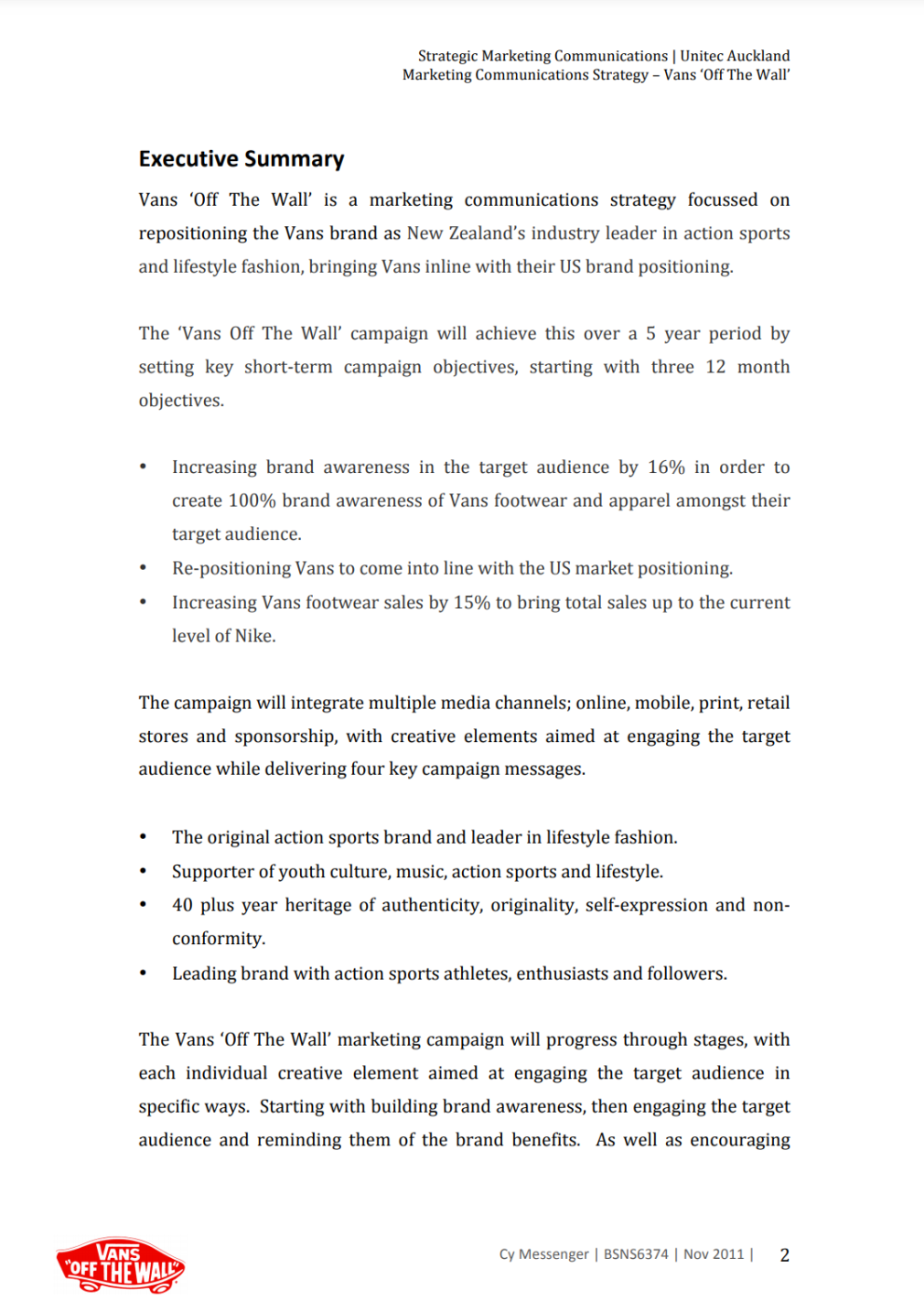
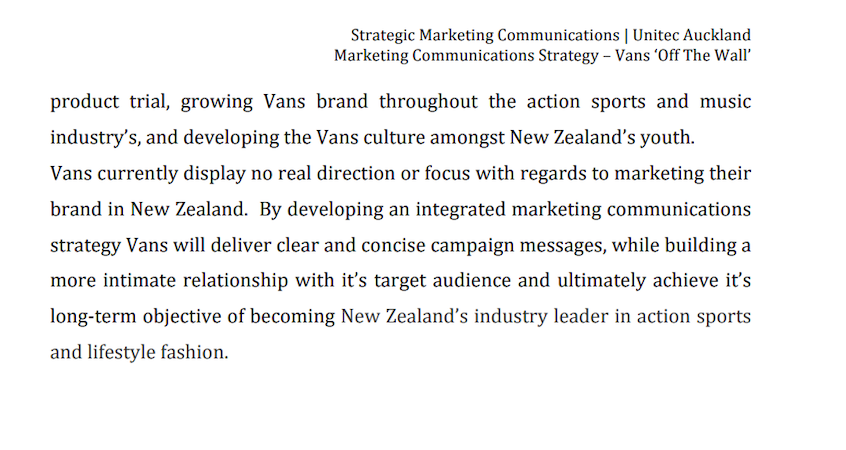
It clearly outlines a series of quantifiable goals that align with the high-level strategic objective of the brand, and then outlines both the channels it will target and the messaging it will use to achieve these goals. It also lays out how these activities will progress over time, and how the methods and techniques used will alter slightly based on these progressions.
Overall, this is a great example of how an executive summary should look.
One Page Marketing Plan
Whereas an executive summary plan is intended to be a summary of all your activities and goals, a 1-page marketing plan is more along the lines of “cram everything onto one page”.
That doesn’t mean the end result should be a disorganized mess, though. As with the Starbucks example below, a well laid out plan can actually give you more clarity, and provide a wealth of information in one small space.
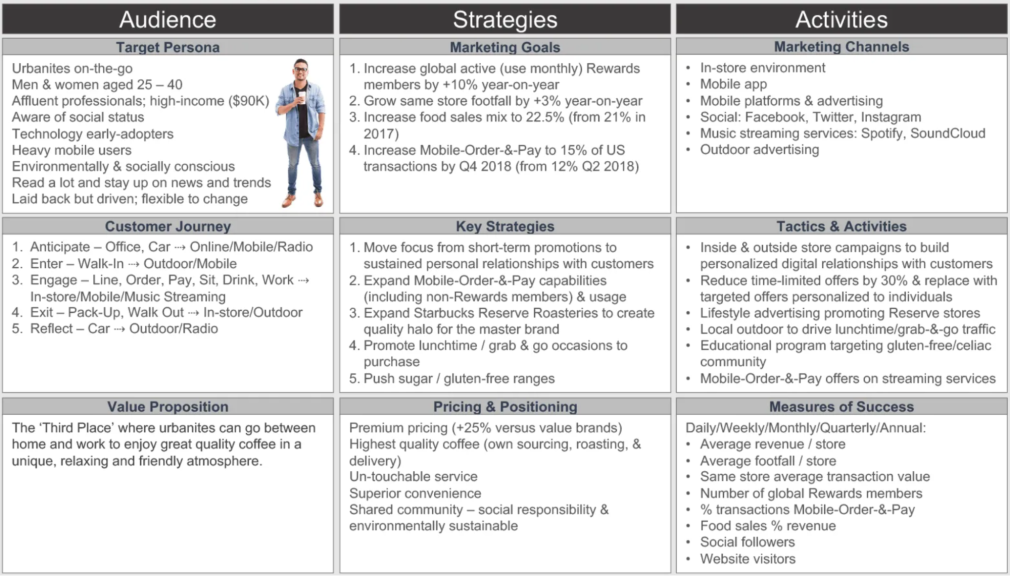
Like the executive summary, there is a clear emphasis on establishing measurable goals that align with the brand’s broader marketing strategy, and there is a wealth of information on the channels, tactics, and metrics that will be used to achieve those goals.
So, now that you know:
what exactly a marketing plan is; why it’s important; the different types of marketing plans; and what they should look like;...it’s time to start creating your own! Next, we’ll discover how to write a marketing plan.
How To Create a Marketing Plan in 8 Steps
You can split this process down into 8 simple marketing plan steps, as follows:
1. State your business’s goals
As mentioned already, your marketing strategy is directly related to your business strategy, which means that you need to identify and state what your business goals are. For instance, it might be your agency’s goal to be the number one social media agency in terms of yearly revenue in your state. Your marketing strategy will be structured in a way that helps you to achieve this goal and, as a result, so too will your marketing plan.
2. Determine the KPIs for these goals
In order to understand if these goals have been met or not, you need to establish how exactly you are going to measure them. That means identifying which marketing KPIs are the most suitable. For example, if one of your goals is to grow your agency’s presence on LinkedIn, you might use a traditional metric such as the number of new followers or engagement rates on posts.
Alternatively, you might create your own KPIs in-house, such as only measuring interactions with companies of a certain size and/or industry.
3. Identify your client profile
One of the most important components of a marketing plan is identifying who exactly it is aimed at. Therefore, you need to establish and state your ideal customer profile. You should identify the kinds of businesses your agency is looking to target, including their size, industry, and other key information, but you should also establish a buyer persona for the key decision-makers that you are going to target.
4. Research all your competitors
As with most marketing decisions, it’s unwise to proceed until you have a good understanding of what your competitors are doing — and what is working for them. To perform market research, you can use several Semrush tools, including Semrush .Trends.
To get started, go to the Market Explorer tool and enter your domain, and select ‘Industry Competitors’ (alternatively, you can create your own competitor list using the ‘Create Custom Market’ option). This will allow you to see a full breakdown of your competitor's market share, traffic trends, traffic sources, and more. You can then use Traffic Analytics to dig even deeper into each competitor and identify their online strengths and weaknesses through a variety of metrics, audience insights, and reports.

5. Create an actionable marketing strategy
Once you know what your goals are, how you’re going to measure them, who you are targeting, and what your competitors are doing, it’s time to break down what your actual approach is going to be. You need to consider and clearly state:
Which channels and platforms you’re going to target (i.e. LinkedIn, Google Ads, industry-specific online forums, and industry-specific offline publications). What your key short-term strategies and approaches are going to be (attend conference X, increase paid ad campaigns, and achieve top 10 SERP ranking for keyword Y). Which tactics and techniques you are going to use (i.e. print brochures and portfolios to hand out at events, outsource X blog posts to Semrush Marketplace, and target media space on competitor destination sites). What your value proposition is (i.e. what sets you apart from your competitors). This doesn’t need to be sugar coated in “marketing speak” as it’s not intended to be seen by leads or clients, so you can be pretty forthright here.6. Define your marketing budget
For most agencies, your budget dictates the activities and strategies that you are able to adopt, so you will likely already have an idea in mind of how much expenditure you’re willing to spend. You need to plan out your budget thoroughly, though, and account for exactly how much will need to be spent and on what.
7. Outline your plan’s contributors and their responsibilities
The various elements of your marketing plan will likely be handled by different people, so you need to outline who exactly is responsible for what, both in terms of delivery and success.
For instance, if one of your approaches is to target social media growth, then this might be the responsibility of your social media manager, while Display campaigns might come under the remit of both your paid ads manager and your media buyer. Ensure that everybody knows what exactly they are meant to be doing when it comes to executing the plan.
8. Set tracking and/or reporting guidelines
When it comes to measuring progress, you need to set out how often you are going to report (i.e. daily, weekly, or monthly), and in what guise. For example, you may want to schedule in-person meetings between key stakeholders every week.
Alternatively, if you are using the Semrush My Reports tool, you might prefer to send and receive automated PDF email reports every day. Whatever you choose to do, make sure the guidelines are clearly communicated in the document.
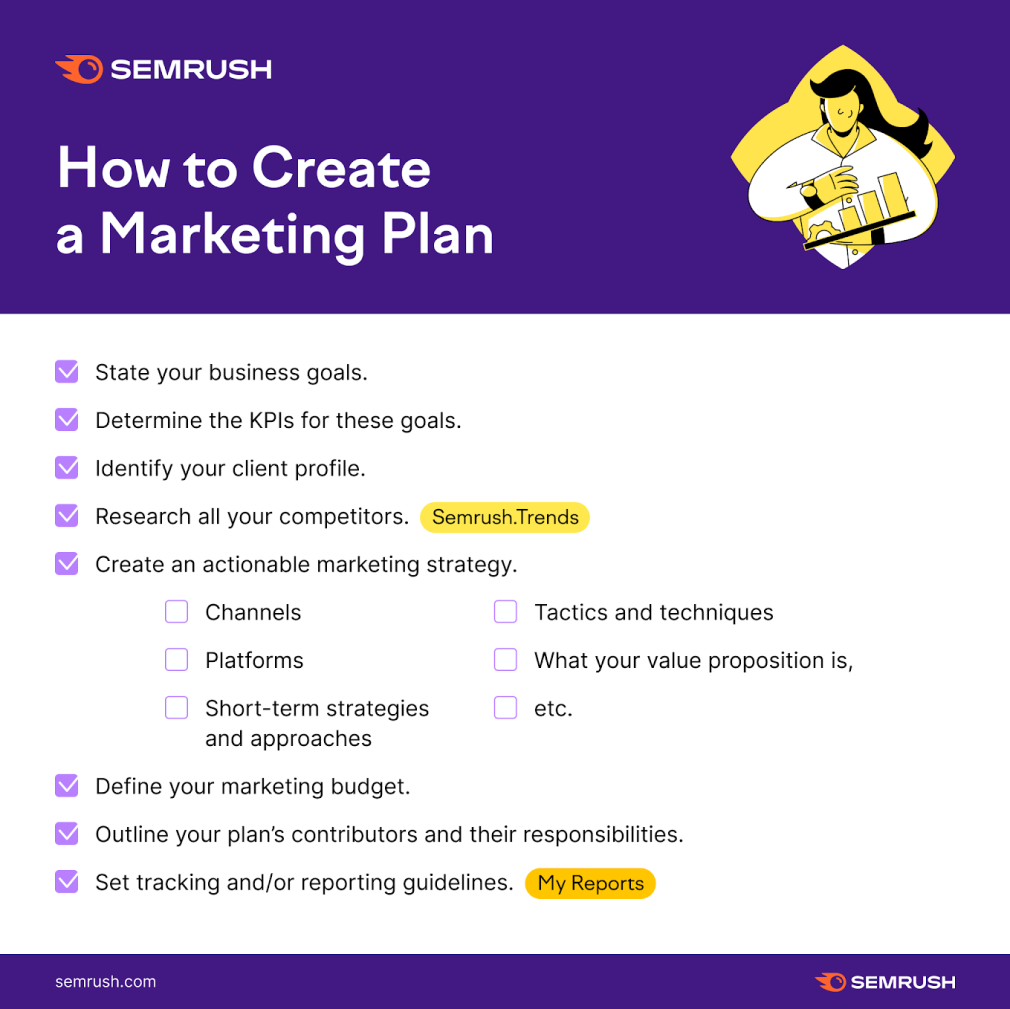
So, now that you know what you need to cover in the document, how exactly do you lay everything out?
Marketing Plan Outline
In terms of the structure of your document, here’s a rough outline of how things should look:
Executive summary. As mentioned, this is a two-page summary at the start of your document that gives a brief overview of everything you’re going to do in your plan. Business information. To provide context, you should provide some key points about your brand, including who you are, what your mission statement is, and what your wider business goals are. Introduction to your goals. You will already have touched upon your marketing goals in the executive summary, but here you should lay out in a lot more detail what you’re hoping to achieve, why you have set these smart goals, and how they align with your business objectives. Competitive analysis. This section should contain the key findings of the competitor research you’ve conducted. In particular, talk about the channels your competitors are successfully using, the sources they’re getting their traffic from, the top products and pages on their sites, and the kinds of ads they’re running. SWOT analysis. Within your marketing plan, you should also conduct a SWOT analysis of your agency. This will help you to better understand your own strengths, weaknesses, and opportunities, and create a more effective, self-aware marketing plan going forward. Target market overview. To better understand your own goals and performance, as well as those of your competitors, you need to have a high-level understanding of your target market. You can draw on data from Market Explorer (such as traffic size, trends, and growth regions), but you can also consult industry publications (online and offline), forums, and other public channels such as social media to get a more informed overview. Customer journey map (CJM). In order to more effectively target and generate effective leads, you need to know how the process typically works. Explore the kinds of sources and channels that your target leads typically come from, and analyze the steps they take at each stage of the funnel. You can then use this information to create your own CJM. Unique selling proposition (USP). As mentioned, it’s important to establish what sets your agency apart, as you will likely lean heavily on this in your content and other promotional materials. Branding. In this section, you should discuss how your brand is currently perceived, both in general and among your target audiences. You should consult with your PR and reputation manager(s) here. You should also talk about how you’d like your brand to be perceived, especially if changing those existing perceptions is one of your direct goals. Marketing channels. Here is where you should outline all the marketing channels that you plan to target in your plan. List every single platform on which you plan to have a presence, along with an explanation of how each channel fits into your wider approach. Measurements and KPIs. As discussed, you also need to clarify how you’re going to measure whether the outcome of the plan has been successful. This is where you should detail the exact metrics and measurements that allow you to do this. Marketing strategy and tactics. Again, as discussed, here is where you need to list the tactics and techniques that you are going to adopt. Conclusion. Your marketing plan is essentially a report, so it should have a conclusion. In this section, you can provide any additional key information and reinforce the objectives of the plan.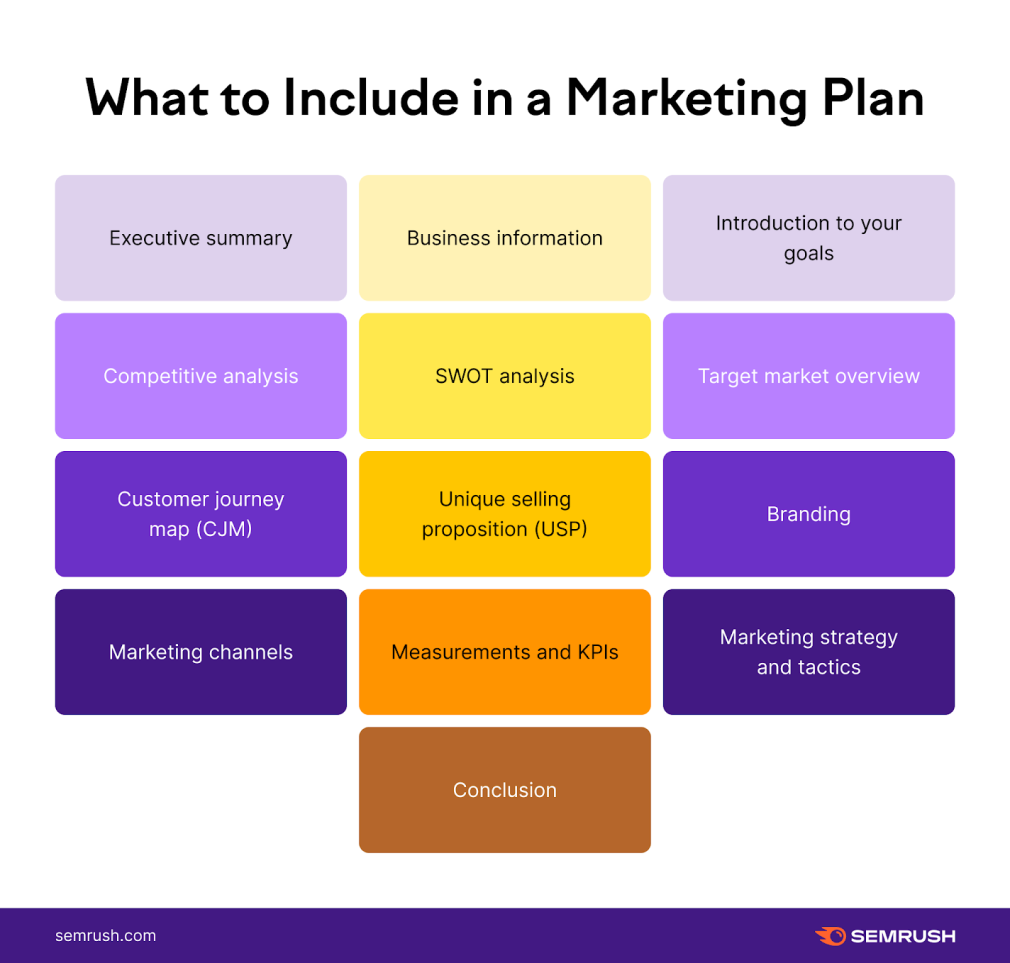
Free Marketing Plan Template
At this point, you might be thinking that this sounds like a lot of work — or maybe you don’t know where to start.
With this in mind, we’ve created a free white-label marketing plan template that you can download and use, allowing you to focus on researching and devising your strategy and your tactics.
To download the template, simply follow the link below.
[GET MY FREE TEMPLATE]
Final Thoughts
If you know how to make a marketing plan that is well-structured and thoroughly researched, then you can implement your strategies more effectively, and generate better leads and results for your agency as a result.
Semrush provides a wealth of tools and workflows that can assist in the marketing plan process, but we can also directly help your agency in other ways.
Our ‘for Agencies’ subscription plans are tailored specifically to the needs and requirements of agencies, giving you access to many of these tools. They also allow you to:
Manage all your clients in one place with our dedicated Client Manager platform. Prospect and pitch directly to potential clients. Create dynamic, automated reports for clients and internal use.To claim your free trial and to find out more about Semrush for Agencies, simply follow the button below!
Innovative SEO services
SEO is a patience game; no secret there. We`ll work with you to develop a Search strategy focused on producing increased traffic rankings in as early as 3-months.
A proven Allinclusive. SEO services for measuring, executing, and optimizing for Search Engine success. We say what we do and do what we say.
Our company as Semrush Agency Partner has designed a search engine optimization service that is both ethical and result-driven. We use the latest tools, strategies, and trends to help you move up in the search engines for the right keywords to get noticed by the right audience.
Today, you can schedule a Discovery call with us about your company needs.
Source:





